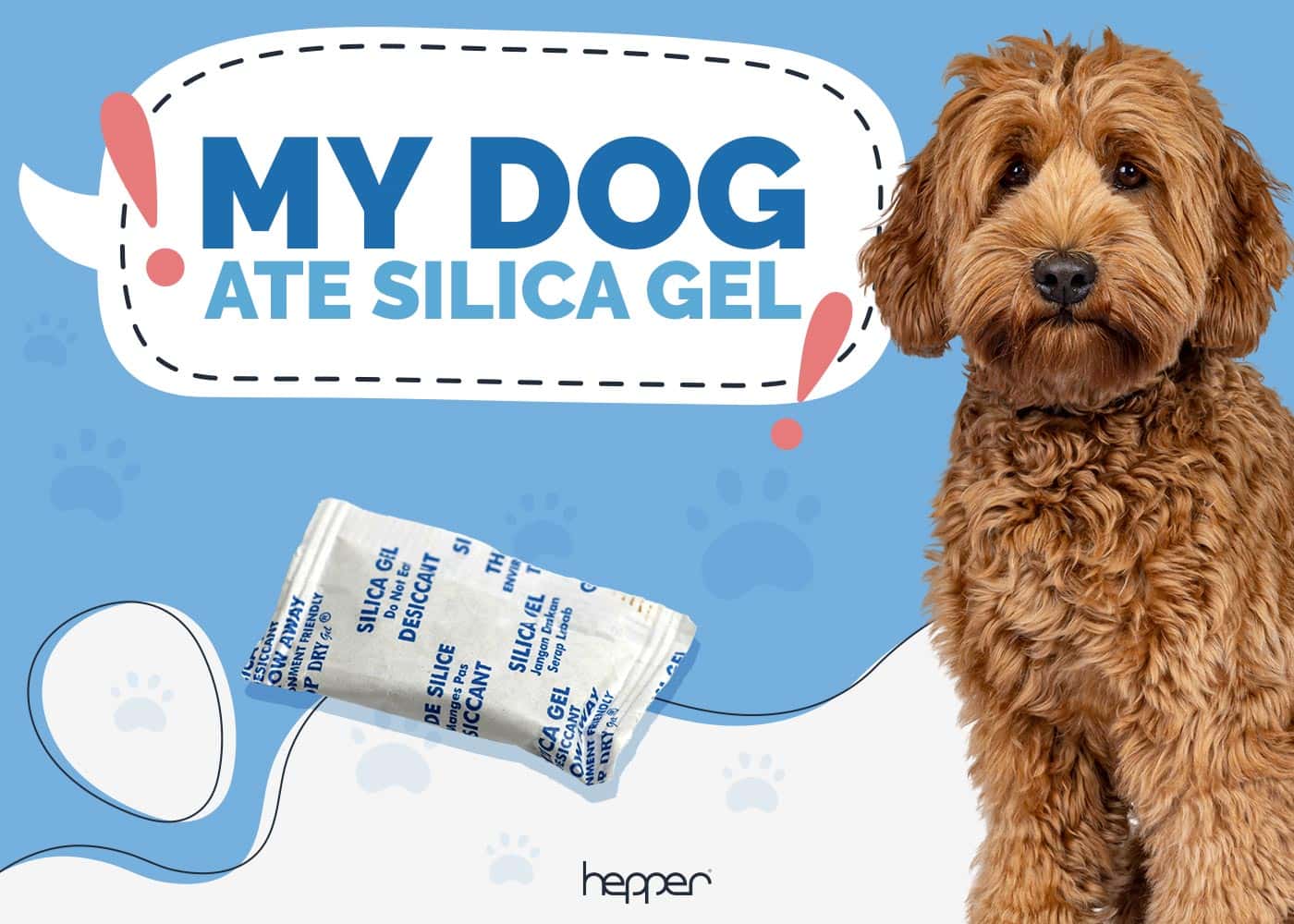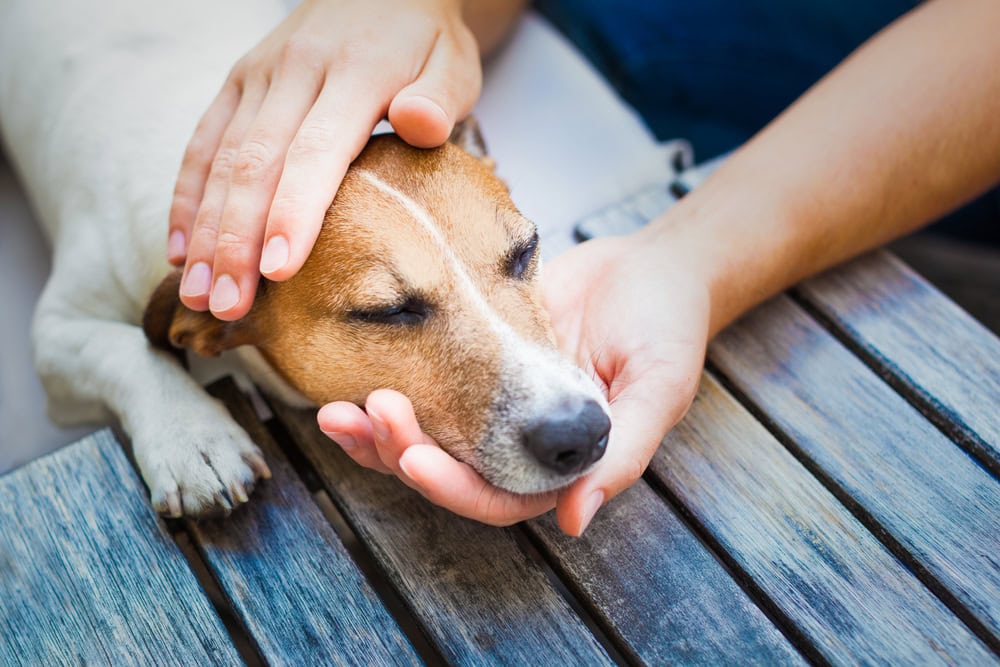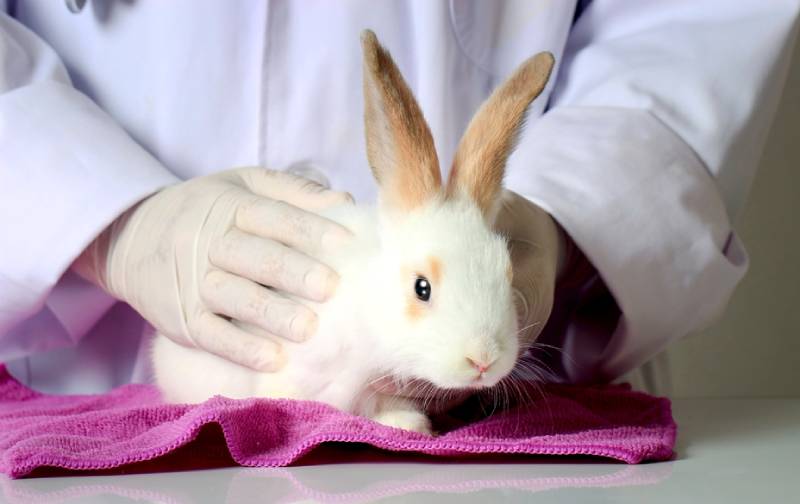My Dog Ate Silica Gel! Our Vet Explains What to Do

Updated on

Click to Skip Ahead
Those little packets saying “do not eat” that you find inside packages, new handbags, and dried goods contain silica gel—an inert substance that acts as a desiccant. If you’ve come home to find your dog ate a silica packet, you’re not alone!
In this case, don’t make your dog vomit, and immediately call the vet. Read our article for advice on what to do if your dog eats silica gel.
What Should I Do if My Dog Ate Silica Gel?
- One: First, stop them from eating anymore! Remove any remaining silica gel packets and put them away in a secure location. You may need to remove your dog from the area so that you can return and clean up the mess!
- Two: Do not try to make your dog sick. It is never advisable to make your pet sick at home without talking to your veterinarian first, as this may not be necessary and, in some circumstances, may even be detrimental to your pet.
- Three: Contact your veterinarian. Be sure to inform your veterinarian of how much silica gel has been eaten. You may need to estimate this if you are unsure. Other important details that your veterinarian will need include your dog’s age, breed, and weight. It is important to contact your veterinarian even if your pet looks OK now, as they may become poorly later on if left untreated.
What Is Silica Gel?
Little packets of silica gel are placed within many different products, such as food, clothing, and electrical items, as they help absorb water vapor, thus preventing products from getting damp and becoming damaged or soiled. The silica gel balls or beads contained within these little packets are essentially silicon dioxide, a porous form of sand.

Is Silica Gel Toxic to Dogs?
While the silica gel itself is not toxic to dogs, ingestion of significant quantities may result in an upset stomach. If your dog eats large quantities of silica gel, this may result in a blockage within the gut. It is also important to consider whether your dog has ingested additional items, such as the item that contained the silica gel packet, since this may lead to additional varied signs. It is best to contact your veterinarian for advice when your dog has eaten something that it shouldn’t have or if you are uncertain about the safety of the ingested item.
- Drooling
- Vomiting
- Abdominal pain
- Diarrhea
- Inappetence
- Lethargy
What Happens if My Dog Has Eaten Silica Gel?
Depending on the size of your dog and the amount of silica gel they have eaten, it may be necessary for a veterinary visit for further assessment and treatment. This may include inducing vomiting, X-rays, or hospitalization for observation and treatment.
Alternatively, your veterinarian may suggest monitoring at home is necessary. If your veterinarian would like you to monitor your dog, you should look for any signs that your dog is not feeling like their normal self. This may include signs of an upset stomach, such as vomiting, nausea, drooling, and abdominal pain. Lethargy and diarrhea may also be seen. You may also notice silica gel packets being passed in your dog’s stool.
You should contact your veterinarian with an update if your pet’s condition and signs are worsening, especially if you notice lethargy or that your dog cannot keep food or water down. If your dog is not passing feces or struggling to defecate, it is advisable to contact your veterinarian urgently.

Will My Dog Be Okay After Eating Silica Gel?
If your dog eats silica gel but only a small amount, this is unlikely to cause any harm to your dog. Silica gel is not toxic to dogs, and most dogs will pass the contents of a packet without any further symptoms.
Ingestion of silica gel beads may result in signs of an upset stomach, especially if a large amount is eaten relative to your dog’s size; for instance, if a small dog eats a large packet of silica gel. If this is the case, you may see abdominal pain, vomiting, or diarrhea.
In rare cases, a blockage within the gut may occur, especially if large quantities of silica gel are consumed, and the packet has also been eaten. The blockage may occur anywhere within the gastrointestinal tract, including within the esophagus, stomach, or intestines. The signs of a bowel obstruction are very similar to an upset stomach. Blockages can quickly become life-threatening, so if you suspect a problem, you should contact your vet, who may need to operate on your dog to save their life.
Why Has My Dog Eaten Silica Gel?
Dogs have a heightened sense of smell and many of them are very interested in their surroundings. This means that dogs will often gobble up the most bizarre items that may not always be edible, let alone safe for them. Silica gel is one of those items that may interest your dog and, believe it or not, it is a relatively common occurrence for dogs to eat silica gel.
Dogs may be interested in eating silica gel because it smells like the tasty thing it was packaged with. They’re often included in packs of treats to stop them from absorbing moisture and spoiling. Sometimes, there’s no known reason for a dog to eat silica gel—they just ate it! However, if your dog is regularly chewing or eating inedible items, we recommend having a check-up with your veterinarian to discuss the possibility of a medical or behavioral cause.
Some dogs may be more interested in eating inedible items than others, but it will depend on their age and personality. Puppies that are teething or playful dogs are likely to seek out items to chew and may inadvertently ingest that item without realizing that it is harmful to them. It is advisable to research and understand what is or isn’t safe for our dogs and ensure that inedible and dangerous products are put out of reach of our beloved family pet.
Keep reading to find out everything that you need to know. We will look at whether silica gel is toxic to dogs, what to do if they ingest it, and how to prevent dogs from eating inedible items in the first place.

How to Prevent Dogs From Chewing or Eating Things They Shouldn’t
Prevention is always better than cure, and therefore, we must keep potentially harmful items like silica gel away from our dogs and out of reach. It may be necessary to dispose of harmful products in sealed trash bins to protect from scavenging behavior or to place locks on cupboards and fridge freezers to protect from unwanted invaders. Providing dogs with plenty of safe toys and chews may be all that is necessary to prevent boredom and scavenging. Try not to get mad at your dog if they gain access to forbidden items, as this, unfortunately, can further encourage this behavior.
As previously mentioned, dogs that are regularly ingesting non-food items may require assessment by your veterinarian for underlying medical or behavioral causes.
Final Thoughts
We hope this article sheds some light on what happens when your dog eats silica gel. As we stated, a small amount of silica gel is not likely to cause harm. However, depending on the size of your dog, it could cause stomach upset. Make sure you pick up any silica gel packets or pellets from the floor so your dog does not eat anymore. Look for signs of stomach upset and contact your vet just to be safe.
See also:
- My Dog Ate a Tampon! Here’s What to Do (Vet Answer)
- My Dog Ate Insulation: Our Vet Explains What to Do
Featured Image Credit: multifacetedgirl, Pixabay













